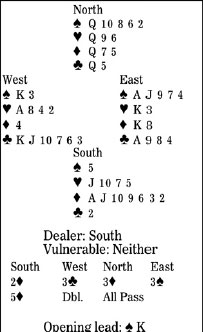It is easier with visible cards
By Phillip Alder ( China Daily ) Updated: 2017-03-04 07:23:04Hans Rosling is a Swedish medical doctor who rose to prominence when he produced a Ted Talk in which he promoted the use of data to explore development issues. He said, "My best friend in medical school was a magician. We were shown an X-ray of a sword swallower, and I tried it and failed. Then I got a sword swallower as a patient, and he taught me."
If you know how to do something, it seems easy. But until you do, it can appear very difficult.
At the bridge table, we would all play better if we had X-ray vision. In this deal, for example, what happens in three no-trump after West leads the diamond three?
South starts with six top tricks: one spade, two hearts, two diamonds and one club. He should hope that East has the club king and that he can get four heart tricks. What is the best play in the heart suit?
Ideally, you run the nine. Then, assuming it loses to the jack or queen, you cash the ace and king. Your chances are just under 50 percent. Here, though, declarer's communications are imperfect.
The simplest-looking line is to win the first trick with dummy's diamond king and to lead a club toward the queen. Suppose East takes that trick and returns a diamond. South should win that, cash the club queen, then lead a low heart from his hand. Yes, the defenders take that trick and two diamond winners, but when hearts prove to be 3-3, declarer is home.
Note, though, that if East had shifted to the spade four at trick three, it would have defeated the contract - not easy.

|
|
|
|
|
|
|
|

























 Raymond Zhou:
Raymond Zhou: Pauline D Loh:
Pauline D Loh: Hot Pot
Hot Pot Eco China
Eco China China Dream
China Dream China Face
China Face






